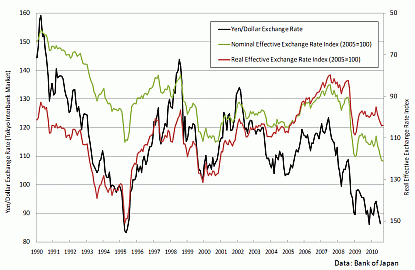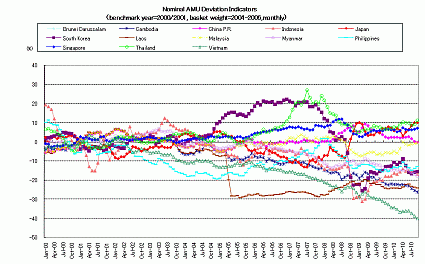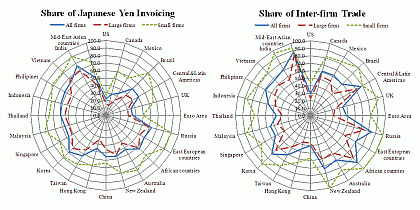After the yen strengthened to about 85 yen per U.S. dollar (hereinafter simply referred to as "dollar") in August, the rising value of the Japanese currency has received wide media coverage in Japan. With the yen approaching its postwar record high of 79.75 yen per dollar, marked in April 1995, there have been significant calls for swift government action to address the situation. However, is the current level of the yen/dollar exchange rate - 85 yen to the dollar - that extreme? Do we really have to express such concern day after day?
Value against the U.S. dollar is not the sole exchange rate measure
According to the trade statistics for the first six months of 2010 released by the Ministry of Finance in July, exports to the United States accounted for only about 15% of the total value of Japan's total export value. Under this situation, measuring the value of the yen only in terms of its exchange rate against the dollar would result in biased judgment. So, let's compare changes in the yen/dollar exchange rate with those in the effective exchange rate of the yen, which is calculated as a trade-weighted average of the yen to the currencies of Japan's major trading partners. Figure 1 shows changes in the yen/dollar exchange rate and the nominal and real effective exchange rate indices between January 1990 and September 2010. From this, we can see that the yen, measured in terms of the nominal effective exchange rate index, has strengthened beyond the level in April 1995 when the Japanese currency hit its record high against the dollar. But the figure also shows that the yen has weakened by about 30% since April 1995 in terms of the real effective exchange rate index. This means that the current level of the yen, 81-82 against the dollar, is not so outrageously high in real effective terms.

[Click to enlarge]
Furthermore, according to the aforementioned trade statistics, exports to Asia accounted for about 56% of Japan's total export in January-June 2010. Thus, it is critical for Japan to monitor the fluctuation of the yen not only against the dollar but also against other Asian currencies. Figure 2 shows the Nominal Asian Monetary Unit (AMU) Deviation Indicators released by the Research Institute of Economy, Trade and Industry (RIETI). It shows that the Nominal AMU Deviation Indicator for the yen turned positive after the collapse of Lehman Brothers in September 2008 and has been relatively strong among East Asian currencies. However, we can also see that the relative value of the yen vis-a-vis other East Asian currencies increased by 10% from the benchmark years of 2000 and 2001 with the relative value of the yen in the latest months roughly comparable to that in January 2009 when the yen strengthened beyond the 90 mark against the dollar.

[Click to enlarge]
Therefore, it is not appropriate to discuss future policies based solely on the nominal yen/dollar exchange rate. From the medium to long term standpoint, the real effective exchange rate, which has a significant influence on the real economy and trade structure, is more important. Or if priority is to be given to the relationship with East Asian countries in which Japanese companies have established manufacturing bases, Japan should be looking at the relative value of the yen against the currencies of those countries in formulating its foreign exchange rate policy, for instance, by referring to the AMU Deviation Indicators.
Why do Japanese companies not invoice exports in their home currency?
The reason why the strengthening of the yen quickly turns into an economic and political issue in Japan is that many Japanese companies invoice their exports in the dollar. If their exports are invoiced in the yen, their business performance would not be affected by a stronger yen at least for a short-time horizon. Despite the fact that Japan is a developed country and the Japanese yen is one of the key international currencies, why has the yen failed to become the currency of choice for Japanese exporters?
Ito, Koibuchi, Sato, and Shimizu (2009, 2010) interviewed and conducted a questionnaire survey of major Japanese exporters regarding their choice of invoice currency for their exports, and indentified three major factors affecting the choice of invoice currency.
A first factor is intra-company trade observed primarily in major companies. The majority of Japan's leading exporters have affiliates in major overseas markets and intra-company exports from Japanese parents to their overseas affiliate account for a significant portion of Japan's exports. Japanese exporters typically make it their policy to have their head office treasury department centrally manage all currency risks for their overseas affiliates. That is, exports from Japanese parents to overseas affiliates are invoiced by the importer's currency so that currency risks associated with transactions will be borne by the Japanese parents, as they are better equipped to cope with the risks. A second factor is the nature of Japanese companies' manufacturing affiliates in Asia, particularly those of electric equipment manufacturers. Those manufacturing affiliates also serve as a base for exports to markets outside Asia, typically, the U.S., and exports from Asia to the U.S. are usually invoiced in the U.S. dollar. Thus, as a way to minimize exposure to foreign exchange risk by their manufacturing affiliates in Asia, Japanese companies use the dollar as the invoice currency for transactions with those affiliates and hence have their head office treasury department absorb and manage the risk. The third factor is the competitiveness of goods exported. Companies with a competitive advantage, those producing differentiated products and holding a dominant share in the world, show a marked tendency to seek to use the yen as the invoice currency even in exports to developed countries.
Figure 3 shows the share of yen-invoiced exports in Japan's total exports by country/region as set out in our questionnaire survey. The data points represented by three polar lines indicate the average share of yen-invoiced exports by destination, respectively for all the surveyed companies, "large companies," and "small companies." For the purpose of this chart, large companies are defined as those ranked in the top third in terms of consolidated sales, and small companies as those ranked in the bottom third. From this, we can see that in exports to all destinations, the share of yen-invoiced exports for large companies is substantially smaller than that for small companies. Large companies tend to use the importer's currency, instead of the yen, as the invoice currency for exports to developed countries that have a currency with low transaction costs. Meanwhile, regarding exports to Asian countries, because of high transaction costs, they rarely use the currency of those countries. Instead, the dollar, a third-country currency, is used just as much as - if not more than - the yen. These survey findings strongly suggest that the characteristics of the choice of invoice currency for Japan's exports are attributable to the characteristics of large-scale exporters. They also show a distinctive difference in the pattern of invoice currency choice between large and small companies, that is, small companies with no or insignificant intra-company trade use the yen in a relatively large portion of their exports, whereas large companies with significant intra-company exports to their overseas affiliates do not insist on the use of the yen.
(excluding exports to overseas affiliates) in Japanese trade by destination

[Click to enlarge]
Policy implications
The research findings discussed above suggest that Japanese exporters with a global production and sales network have been using the dollar, instead of the yen, as the invoice currency of their rational choice based on clear foreign exchange strategy according to the given environment surrounding their business operations. For leading Japanese exporters whether to invoice in the yen or the dollar is simply a matter of who within their group - head office or individual affiliates - bears the foreign exchange risk arising from their operations. Therefore, the group-wide foreign exchange risk management of such companies is considered proper and adequate.
Thus, in the face of the current appreciation of the yen (as of September 3, 2010), what the Japanese government should be doing is not considering intervening in the market to prevent a further rise of the yen over a short time period (although such a move may become necessary depending on the future movement of foreign exchange rates, the Bank of Japan should step in only when all the necessary conditions are in place), but setting out a clear policy to make the Japanese economy more resilient to fluctuations in the yen's value over a long time horizon and establish a necessary environment to achieve that end. More specifically, the government should help companies to develop cutting edge technologies that are unparalleled in the world and enable them to invoice their exports in the yen. At the same time, it should seek to develop a freer market environment that enables Japanese companies to implement efficient foreign exchange strategies, thereby supporting them to build global business - which includes overseas production and sales, imports reasonably balanced with exports, and the global management of foreign exchange risk - in such a way that their business performance would remain unaffected by the strengthening or weakening of the yen. Concern has been voiced that the recent surge in the value of the yen may drive more companies to relocate manufacturing bases to overseas locations, leading to the further hollowing out of Japanese industry. However, global business operations are not necessarily a growth-impeding factor (for companies). There is no doubt that the proportion of domestic business will fall and there is concern that the nation's unemployment rate will rise as a result. But if that is the case, it makes it all the more necessary for the government to implement educational policy with an eye on the globalization of competent human resources, particularly in the young generation. Also, the government should ensure that Japanese companies will not be put at disadvantage when exporting, stepping up efforts toward an early conclusion of free trade agreements (FTAs) or economic partnership agreements (EPAs) with the governments of countries that are Japan's major trade partners, thereby having them lower tariffs on imports from Japan.



